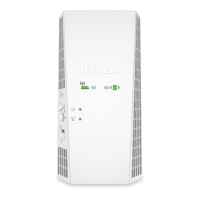
Do you have a question about the NETGEAR EX7300v2 and is the answer not in the manual?
| Device Type | Wi-Fi Range Extender |
|---|---|
| Model | EX7300v2 |
| Wireless Standard | 802.11ac |
| Maximum Speed | 2200 Mbps |
| Ethernet Ports | 1 x Gigabit Ethernet |
| Antennas | External Antennas |
| MU-MIMO | Yes |
| Beamforming+ | Yes |
| Frequency Band | 2.4 GHz & 5 GHz |
| Security | WPA/WPA2 |
| Weight | 0.66 lb (0.3 kg) |
| Setup | Web Browser Setup |
Describes the status indicator lights on the extender for different operational states.
Details the physical components and ports located on the extender's side and bottom panels.
Guidance on when and where to best utilize the WiFi range extender.
Explains the operational principles and role of the extender within a network.
Step-by-step instructions for setting up the extender to expand existing WiFi coverage.
Guide for configuring the extender to function as a WiFi access point.
Methods for connecting computers and mobile devices to the extended network.
Instructions for connecting wired devices to the extender using an Ethernet cable.
Utilizing WPS for a quick and secure connection of devices to the extender.
Accessing the extender's web interface for management after initial setup.
Using the guided setup wizard for initial configuration and network connection.
Configure a single WiFi network name and password for seamless roaming.
Manage automatic band selection for devices to optimize performance.
Monitor all devices currently connected to the extender's WiFi network.
Review current WiFi network configurations, including SSIDs and security.
Customize the Service Set Identifier for the extender's WiFi network.
Conceal the WiFi network name to enhance network security.
Control the activation of the 2.4 GHz and 5 GHz WiFi radio bands.
Adjust the speed configuration for the 5 GHz WiFi network band.
Use Wi-Fi Protected Setup for simplified device connection.
Block specific devices from connecting to the extender's network via MAC address.
Create timed restrictions for wireless or wired network access.
Customize the name assigned to the extender within the network.
Assign a fixed IP address to the extender for stable network integration.
Adjust router MAC filtering to ensure proper extender and device connectivity.
Optimize network performance for HD entertainment and gaming using dedicated bands.
Manage WiFi channel width to balance speed and minimize interference.
Update the administrator credentials used to access the extender's settings.
Manage the security setting to enable or disable access to the extender's interface.
Steps to retrieve lost login username or password using security questions.
Configure the extender to automatically adjust its clock for daylight saving time.
Set the extender's internal clock manually for accurate access scheduling.
Save the current extender configuration to a file for backup purposes.
Load previously saved settings to revert the extender to a prior configuration state.
Restore the extender to its original out-of-the-box configuration and settings.
Check for and install the latest firmware for improved performance and security.
Reboot the extender through its web-based management interface.
Answers to common questions encountered during extender setup and operation.
Methods to locate the extender's IP address on the network.
Solutions and troubleshooting steps for connection issues to the extender.
Troubleshooting WiFi connection failures that display error messages.
Resolving problems encountered when trying to access the extender's web interface.
Lists the default configurations for the extender's features and network settings.
Details on the extender's hardware capabilities, operating conditions, and physical properties.